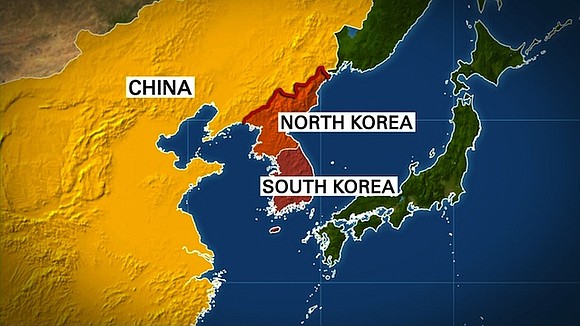North Korea Issues Warning as US Strike Group Heads to Korean Peninsula
CNN/Stylemagazine.com Newswire | 4/11/2017, 8:16 a.m.

By Tim Schwarz, Zachary Cohen and Brad Lendon
CNN
PYONGYANG, North Korea (CNN) -- North Korea has issued a forceful response to the deployment of a US naval strike group to the region, saying it would counter "reckless acts of aggression" with "whatever methods the US wants to take."
In a statement provided to CNN by officials in North Korea, Pyongyang said the "current grim situation" justified its "self-defensive and pre-emptive strike capabilities with the nuclear force at the core."
"We will make the US fully accountable for the catastrophic consequences that may be brought about by its high-handed and outrageous acts," the statement said.
The Pentagon sent the 97,000-ton USS Carl Vinson with an escort of a guided-missile cruiser and two destroyers after the latest missile test by North Korea last week.
On Tuesday, North Korean leader Kim Jong Un is expected to attend the country's Supreme People's Assembly, a high-profile gathering of the nation's leading political figures.
The meeting comes days before North Korea celebrates the April 15 birthday of deceased leader Kim Il Sung, Kim's grandfather -- amid speculation that Pyongyang will mark the occasion with by testing missiles or possibly a nuclear device.
Complicated scenario
Carrying more than 5,000 sailors and 60 aircraft, the USS Carl Vinson is escorted by guided-missile destroyers USS Wayne E. Meyer and USS Michael Murphy and the guided-missile cruiser USS Lake Champlain.
The group's ships and air wing provide significant firepower and strike capability, but balancing the available military options with the potential of retaliation from North Korea presents a complicated scenario for US President Donald Trump.
China -- North Korea's closest ally -- has pressed the US to engage in direct diplomatic negotiations with North Korea.
US Secretary of State Rex Tillerson said Sunday that Beijing understands how dangerous North Korea's nuclear program has become and agrees action must be taken to stop it, but China hasn't signaled any change in its approach to Pyongyang since a summit between Trump and Chinese President Xi Jinping last week.
US allies South Korea and Japan, which has seen previous North Korean missile tests fall within 200 miles of its coast, both supported the deployment of the Vinson group.
South Korea said the group's deployment was recognition of the "grave situation on the Korean Peninsula," while Japan said it was "important to secure the power of US deterrence."
The White House faces a tough task in convincing North Korea to give up its nuclear program, retired Gen. Michael Hayden, a former head of the CIA and National Security Agency told CNN's "New Day."
"No matter what we do there is this move by North Korea to build missiles and put weapons on top of missiles," Hayden said.
"This is what they count on for regime survival. ... The best we can do is box it where it is right now," he said. "I don't think we can make them give up the program."
Missile intercept
Many analysts believe the movement of US warships is likely defensive in nature, setting the stage for a scenario in which the Vinson strike group could be called upon to perform a missile intercept.
The three escort warships traveling with the Vinson have more than 300 combined missile tubes and are outfitted with the Aegis anti-missile system, according to Bruce Bennett, senior defense analyst at the think tank Rand Corp.
"If North Korea were to test some number of ballistic missiles by firing them into the East Sea/Sea of Japan, these warships would have the potential of intercepting the North Korean test missile," Bennett said.
Intercepting a long-range rocket test passing overhead would send a clear message to Kim and would be justifiable as the rockets would possibly be on course to pass over Japan, according to Peter Layton, a visiting fellow at the Griffith Asia Institute in Brisbane, Australia.
"The Carl Vinson group is commanded from Hawaii, rather than the US military base in Japan, so it's a clear American initiative not a Japanese or South Korea one," Layton told CNN. "That may defuse attempts to link Japan and South Korea and thus limit the possibility of any North Korean aggression against them."
While the carrier group has been deployed to the Korean Peninsula in the past, lawmakers are wondering how the US warships will be directed to respond to another North Korean missile test.
"Are we going to try to shoot that intercontinental ballistic missile down? Are we going to let the test go on unpaid on unimpeded? Republican Rep. Will Hurd asked on CNN's "New Day." "These are questions that should be asked of Congress."
Offensive strike capabilities
The Trump administration has floated the idea of carrying out preemptive strikes against North Korea, but the scope and method of potential offensive actions remain unclear.
The Vinson's air wing, made up of more than 40 F/A-18 Hornets, provides the offensive capability to attack enemy targets with bombs or missiles while the carrier's F/A-18G Growler aircraft have the ability to jam enemy radars, disrupt enemy electronic surveillance and provide "cover" for attacking aircraft.
"A potential US strike, using aircraft from the Vinson, could range from a small-scale strike against a single target, like a missile on a launch pad or the support equipment that makes a missile launch possible, to a broader set of military targets if the US meant to 'send a message' that an ICBM (intercontinental ballistic missile) or atomic device test was not going to be tolerated," Dakota Wood, an analyst at the DC-based Heritage Foundation, told CNN.
But the the Vinson strike group may not have the weapons to take out North Korea's nuclear assets, which are buried deep underground, Wood said.
"I believe they would normally be delivered by bomber (B-2, B-1, or perhaps B-52) which could fly from Andersen Air Base on Guam," he told CNN.








